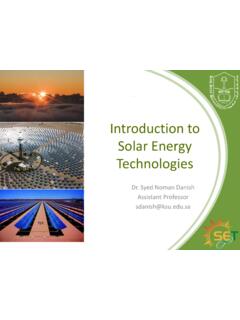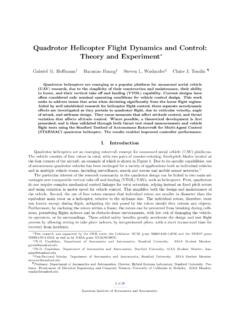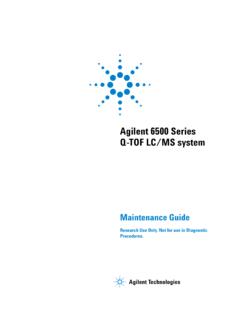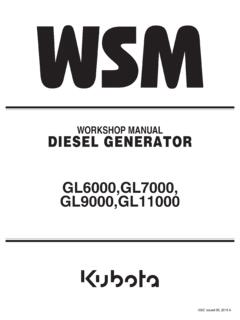Transcription of Introduction to Wind Energy Systems
1 Introduction to Wind Energy SystemsDr. Ali M. EltamalyKing Saud UniversityAgenda Historical Development of WT Current Status and Future Prospects of Wind Energy Types of Wind Turbine Generators (WT) Orientation of WT Sizes and Applications of WT Components of WT Wind Power CalculationsHistorical Development The Babylonian emperor Hammurabi planned to use wind power for his ambitious irrigation project during seventeenth century The wind wheel of the Greek engineer Heron of Alexandria in the 1st century AD is the earliest known instance of using a wind-driven wheel to power a machine Wind-driven wheel was the prayer wheel, which was used in ancient Tibet and China since the 4th century Wind has been used by people for over 3000 years for grinding grain.
2 Sailboats, and pumping water Windmills were an important part of life for many communities beginning around 1200 BC. Wind was first used for electricity generation in the late 19th century. By the 13th century, grain grinding mills were popular in most of Europe French adopted this technology by 1105 and the English by 1191 windmill. The era of wind electric generators began close to 1900 s. The first modern wind turbine, specifically designed for electricity generation, was constructed in Denmark in 1890. The first utility-scale system was installed in Russia in 1931.
3 A significant development in large-scale Systems was the 1250 kW turbine fabricated by Palmer C. Putman. Built around a central postJune 19 20, 2007 Wind Energy Smith Putnam Machine 1941 Rutland, Vermont MW 53 meters (largest turbine for 40 years) Structural steel Lost blade in 1945 Mod-5B Horizontal axis wind turbine is vertical axis wind status and future prospectsSpain also celebrates in Nov. 10, 2010 when the wind Energy resources contribute 53% of the total generation of the example, the European Union targets to meet 25 per cent of their demand from renewable by 2012.
4 Wind is the world s fastest growing Energy source today The global wind power capacity increases at least 40% every 80 percent of the global installations are in Europe. Installed capacity may reach a level of million MW by 2020 The installed capacity from the wind capacity in different regions in the world, 2010.(a) SWAY , , 126 diameterTop ten manufacturers of WTs, of Wind Turbine Generators (WT)1. Horizontal Axis WTs (HAWTs)The HAWT configurations Vertical Axis WTs (VAWTs)The VA-WTs Configurations Orientation of WTTurbines can be categorized into two overarching classes based on the orientation of the rotorVertical AxisHorizontal AxisVertical Axis TurbinesAdvantages Omnidirectional Accepts wind from any angle Components can be mounted at ground level Ease of service Lighter weight towers Can theoretically use less materials to capture the same amount of windDisadvantages rotors generally near ground where wind poorer Centrifugal force stresses blades & components Poor self-starting capabilities Requires support at top of turbine rotor
5 Requires entire rotor to be removed to replace bearings Overall poor performance and reliability/less efficient Have never been commercially successful (large scale)WindspireSavoniousHorizontal Axis Wind Turbines rotors are usually Up-wind of tower Some machines have down-wind rotors , but only commercially available ones are small turbines Proven, viable technologyComparison between HA-WTs and powerWide rangeNarrow range Starting Self startingNeed starting meansEfficiencyHigherLowerCostLowerHighe rWind direction Need redirected when the Wind change its directionDoes not needs redirected into the wind directionGenerator and gear boxAt the top of the towerAt the ground levelMaintenanceDifficultEasyUpwind and DawnwindWTUpwind turbines have the rotor facing the wind as shown in (a).
6 This technique has the following features: Avoids the wind shade that the tower causes which improve the power quality of the generated voltage and reduces the spicks in power when the blades move in front of the tower specially in constant speed Systems . Fewer fluctuations in the power output. Requires a rigid hub, which has to be away from the tower. Otherwise, if the blades are bending too far, they will hit the tower. This is the dominant design for most wind turbines in the MW-rangeDownwind WT have the rotor on the flow-side as shown in (b).
7 It may be built without a yaw mechanism if the nacelle has a streamlined body that will make it follow the wind. Rotor can be more flexible: Blades can bend at high speeds, taking load off the tower. Allow for lighter build. Increased fluctuations in wind power, as blades are affected by the tower shade. Only small wind of Rotor Blades Influence of the number of blades on the rotor power coefficient (envelope) and the optimum tip-speed one blade and ApplicationsSmall ( 10 kW) Homes Farms Remote Applications( water pumping, telecom sites, icemaking)Intermediate(10-250 kW) Village Power Hybrid Systems Distributed PowerLarge (660 kW -2+MW) Central Station Wind Farms Distributed Power Community WindLarge and Small Wind TurbinesLarge Turbines (600-2000 kW) Installed in Windfarm arrays totaling 1 -100 MW $1,300/kW Designed for low cost of Energy (COE)
8 Requires 6 m/s (13 mph) average wind speed Value of Energy : $ -$ per kWhSmall Turbines ( kW) Installed in rural residential on-grid and off-grid applications $2,500-$8,000/kW Designed for reliability / low maintenance Requires 4 m/s (9 mph) average wind speed Value of Energy : $ -$ per kWhSmall Wind Turbines Blades:Fiber-reinforced plastics, fixed pitch, either twisted/tapered, or straight (pultruded) Generator:Direct-drive permanent magnet alternator, no brushes, 3-phase AC, variable-speed operation Designed for: Simplicity, reliability Few moving parts Little regular maintenance required50 kW10 kW400 W900 WWind Turbine componentsYaw systemYaw drive: Upwind turbines face into the wind; the yaw drive is used to keep the rotor facing into the wind as the wind direction changes.
9 Downwind turbines don't require a yaw drive, the wind blows the rotor downwind. Yaw motor: Powers the yaw drive. YAW MECHANISM It is used to turn the turbine against the If the turbine is not perpendicular to the wind, then the power flowing is lower. Almost all HAWT use forced yawing, use electric motors and gearbox. Wind turbine running with yaw error are running with hiherfatigue Aerodynamics of Wind Turbines Important parameters of an airfoil221 VACLaL 221 VACDaD where CLand CDare the lift and drag coefficients ShapeJust like the wings of an airplane, wind turbine blades use the airfoil shape to create lift and maximize efficiency.
10 The Bernoulli EffectLift & Drag Forces The Lift Forceis perpendicular to the direction of motion. We want to make this force BIG. The Drag Forceis parallel to the direction of motion. We want to make this force small. = low = medium<10 degrees = HighStall!!Effect of angle of attack on airfoil liftKidWind Project | Control MechanismsBRAKING MECHANISM It essential for turbines to stop automatically in case malfunction of components. Thus, it is necessary to have an over speed safety system. There are two types of braking breaking braking system It consists of turning the rotor blades or tips about 900about the longitudinal axis.






